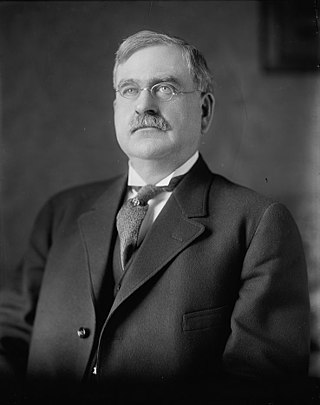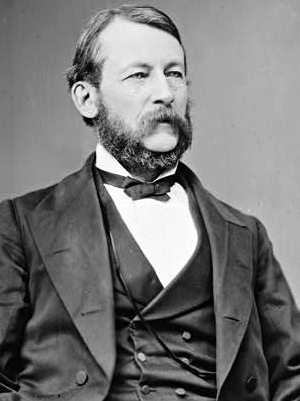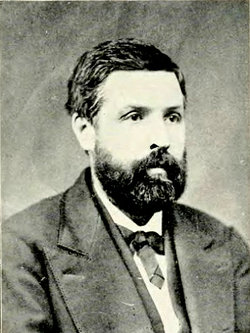Related Research Articles

America's first transcontinental railroad was a 1,911-mile (3,075 km) continuous railroad line built between 1863 and 1869 that connected the existing eastern U.S. rail network at Council Bluffs, Iowa, with the Pacific coast at the Oakland Long Wharf on San Francisco Bay. The rail line was built by three private companies over public lands provided by extensive U.S. land grants. Building was financed by both state and U.S. government subsidy bonds as well as by company-issued mortgage bonds. The Western Pacific Railroad Company built 132 miles (212 km) of track from the road's western terminus at Alameda/Oakland to Sacramento, California. The Central Pacific Railroad Company of California (CPRR) constructed 690 miles (1,110 km) east from Sacramento to Promontory Summit, Utah Territory. The Union Pacific Railroad (UPRR) built 1,085 miles (1,746 km) from the road's eastern terminus at the Missouri River settlements of Council Bluffs and Omaha, Nebraska, westward to Promontory Summit.

Jonathan Prentiss Dolliver was a Republican orator, U.S. Representative, then U.S. Senator from Iowa at the turn of the 20th century. In 1900 and 1908 Republican National Conventions, he was promoted as a vice-presidential candidate, but he was never chosen.

The Crédit Mobilier scandal was a two-part fraud conducted from 1864 to 1867 by the Union Pacific Railroad and the Crédit Mobilier of America construction company in the building of the eastern portion of the first transcontinental railroad from the Missouri River to Utah Territory. The story was broken by The New York Sun during the 1872 campaign of Ulysses S. Grant.

Oakes Ames was an American businessman, investor, and politician. He was a member of the United States House of Representatives from Massachusetts. As a congressman, he is credited by many historians as being the single most important influence in the building of the Union Pacific portion of the transcontinental railroad. He is also noted for the subsequent scandal that alleged the improper sale of stock of the railroad's construction company.

George Eliphaz Spencer was an American politician and a U.S. senator from the state of Alabama who also served as an officer in the Union Army during the American Civil War.

Grenville Mellen Dodge was a Union Army officer on the frontier and a pioneering figure in military intelligence during the Civil War, who served as Ulysses S. Grant's intelligence chief in the Western Theater. He served in several notable assignments, including command of the XVI Corps during the Atlanta Campaign.

Lafayette "Lafe" Young was a newspaper reporter and editor, and (briefly) a Republican Senator from Iowa.

Iowa's 4th congressional district is a congressional district in the U.S. state of Iowa that covers the western border of the state, including Sioux City and Council Bluffs. Up north, it extends eastwards into Ames, Boone, Fort Dodge, and Marshalltown. It has been represented by Republican Randy Feenstra since 2021, who defeated longtime incumbent Steve King in 2020. With a Cook Partisan Voting Index rating of R+16, it is the most Republican district in Iowa, a state with an all-Republican congressional delegation.

William Peters Hepburn was an American Civil War officer and an eleven-term Republican congressman from Iowa's now-obsolete 8th congressional district, serving from 1881 to 1887, and from 1893 to 1909. According to historian Edmund Morris, "Hepburn was the House's best debater, admired for his strength of character and legal acumen." As chair of one of the most powerful committees in Congress, he guided or sponsored many statutes regulating businesses, including most notably the Hepburn Act of 1906. The Hepburn Act authorized the U.S. Interstate Commerce Commission to require railroads to charge "just and reasonable" rates.

Iowa Highway 1 (Iowa 1) is a state highway in the U.S. state of Iowa that extends from Keosauqua to Anamosa. It travels nearly 120 miles (190 km), mainly through rich farmland and small communities. Iowa 1 provides an important link to Iowa City and the University of Iowa as it passes through campus. Portions of the route today date back to the late 1830s, when Martin Van Buren was president, making Iowa 1 one of the oldest routes in the state, pre-dating the current primary highway system by nearly eighty years. The highway was seriously damaged by the Cedar River in the Iowa flood of 2008, which closed the highway for seven weeks.

Thomas Clark Durant was an American physician, businessman, and financier. He was vice-president of the Union Pacific Railroad (UP) in 1869 when it met with the Central Pacific railroad at Promontory Summit in Utah Territory. He created the financial structure that led to the Crédit Mobilier scandal. He was interested in hotels in the Adirondacks and once owned the yacht Idler.

The Mississippi and Missouri Railroad was the first railroad in Iowa. It was chartered in 1853 to build a line between Davenport, Iowa, on the Mississippi River and Council Bluffs, Iowa, on the Missouri River. The railroad was the first west of the Mississippi river to join by bridge to the East. It played an important role in the construction of the First transcontinental railroad although the competing Cedar Rapids and Missouri River Railroad under lease to the Chicago & North Western railroad actually became the first Iowa railroad to reach Council Bluffs from the Mississippi River. Thomas C. Durant, vice president of the Union Pacific Railroad, owned stock in both.

John Adam Kasson was a nineteenth-century lawyer, politician and diplomat from south-central Iowa. Elected to the U.S. House six times, he repeatedly interrupted his congressional service to serve in the Diplomatic service in many different capacities.

Cyrus Clay Carpenter was a Civil War officer, the eighth Governor of Iowa and U.S. Representative from Iowa's 9th congressional district.

The Grenville M. Dodge House is a historic house museum in Council Bluffs, Iowa, United States. This Second Empire mansion, built in 1869, was the home of Grenville M. Dodge (1831-1916), a Union Army general, politician, and a major figure in the development of the railroads across the American West. The house was declared a National Historic Landmark in 1961 for its association with Dodge; in 2005 it was included as a contributing property in the Willow-Bluff-3rd Street Historic District. It is now owned by the city of Council Bluffs and is open for tours.

Benjamin F. Gue was an American newspaper editor, writer and politician in Iowa. He served as a member of Iowa House of Representatives (1858–1862); member of Iowa Senate (1862–1866), and as the Lieutenant Governor of Iowa (1866–1868). He wrote the four-volume History of Iowa From the Earliest Times to the Beginning of the Twentieth Century.

Charles H. Sharman (1841-1938) was a civil engineer who was part of the effort to build the Union Pacific railroad to Promontory Point, Utah in 1869. Sharman was present at the Golden spike ceremony on May 10, 1869, connecting the Central Pacific and Union Pacific railroads at Promontory Summit, Utah Territory. Sharman was also in the Russell photograph of the same date

Marshall Farnam Hurd (1823–1903) was an American civil engineer who was part of the effort to build the Union Pacific railroad to Promontory Point, Utah in 1869. Hurd was present at the Golden spike ceremony on May 10, 1869, connecting the Central Pacific and Union Pacific railroads at Promontory Summit, Utah Territory. Hurd was also in the Russell photograph of the same date

Peter Anthony Dey (1825–1911) was born at Romulus, Seneca County, New York on January 27, 1825. His father was Dr. Philip Dey, a son of Theunis Dey, Colonel of a New Jersey regiment in the Revolutionary war. Dey attended Seneca Falls Academy until 1840, when he entered Geneva College at Geneva, New York, graduating in 1844. He studied law until 1846 when he switched over to civil engineering. His first engagement was for surveying part of the right of way for the New York and Erie Railroad. For the next three years, Dey worked on the Delaware and Susquehanna rivers in Orange County, N.Y., and in Pike and Susquehanna counties in Pennsylvania. In 1849, he was hired by New York state to help rebuild the Cayuga and Seneca Canal locks in Seneca Falls. Then he worked on the Erie Canal at Port Byron.
References
- ↑ "U.S. Marshals Service". 23 June 2020.
- ↑ "Hoxie of Fairfield: From Underground Railroad to Railroad Magnate". Archived from the original on 2014-08-13. Retrieved 2014-08-05.
- ↑ The New York Times, New York, New York, New York, 24 Nov 1886.
- ↑ "Hoxie of Fairfield: From Underground Railroad to Railroad Magnate". Archived from the original on 2014-08-13. Retrieved 2014-08-05.
- ↑ Grinnell, Josiah. "Men and Events of Forty Years". D. Lothrop Company, 1901
- ↑ "Details Page - the Biographical Dictionary of Iowa - the University of Iowa Libraries".
- ↑ "Hoxie of Fairfield: From Underground Railroad to Railroad Magnate". Archived from the original on 2014-08-13. Retrieved 2014-08-05.
- ↑ "Details Page - the Biographical Dictionary of Iowa - the University of Iowa Libraries".
- ↑ Bain, David H., "Empire Express" by Penguin, (2000)
- ↑ Klein, Maury. "The Union Pacific" by the University of Minnesota Press. (2006)
- ↑ "Origin of Town Names" (PDF). Solomon Valley Highway 24 Heritage Alliance. p. 6. Retrieved 9 April 2018.